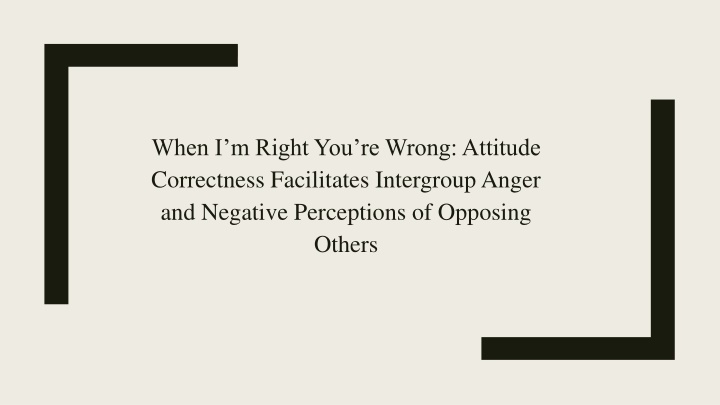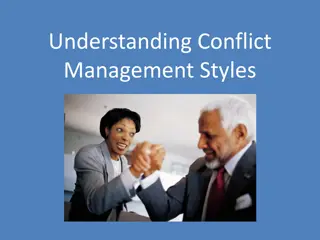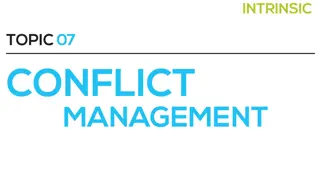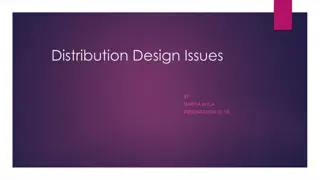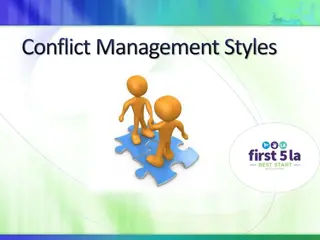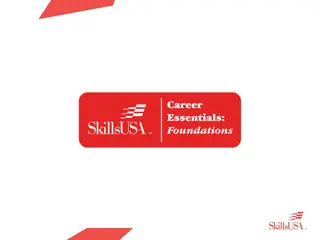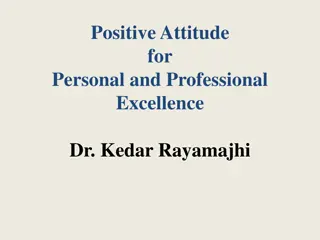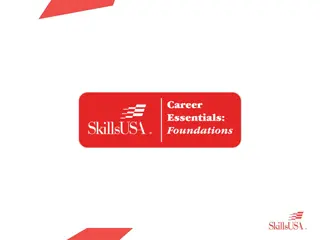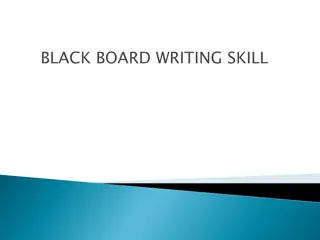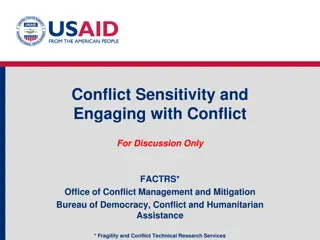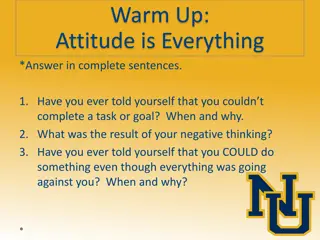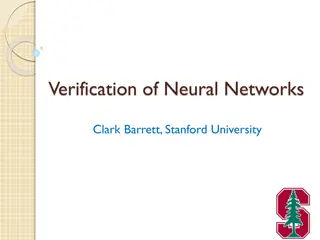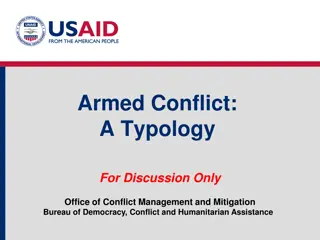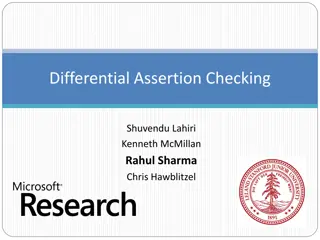Attitude Correctness in Intergroup Conflict
This research explores how attitude correctness influences intergroup anger and perceptions, with hypotheses and methods outlined for further understanding.
Download Presentation

Please find below an Image/Link to download the presentation.
The content on the website is provided AS IS for your information and personal use only. It may not be sold, licensed, or shared on other websites without obtaining consent from the author.If you encounter any issues during the download, it is possible that the publisher has removed the file from their server.
You are allowed to download the files provided on this website for personal or commercial use, subject to the condition that they are used lawfully. All files are the property of their respective owners.
The content on the website is provided AS IS for your information and personal use only. It may not be sold, licensed, or shared on other websites without obtaining consent from the author.
E N D
Presentation Transcript
When Im Right Youre Wrong: Attitude Correctness Facilitates Intergroup Anger and Negative Perceptions of Opposing Others
Purpose The Purpose of this research is to examine factors that contribute to intergroup conflict.
Background Attitude certainty Attitude clarity Attitude correctness Attitude correctness and conflict (Rios, DeMarree, Statzer, 2014) Attitude correctness and persuasion (Cheatham & Tormala, 2015)
Background Intergroup conflict and emotions ( Mackie & Devos, 2000) Intergroup conflict and perception (Fiske & Cuddy, 2002)
Hypotheses We predict that increasing attitude correctness will cause H1: More intergroup anger H2: Intentions to approach the outgroup. H3: Perceptions of lower outgroup competence. H4: Perceptions of lower outgroup warmth.
Method Participants: Participants: 390 Amazon mTurk workers 182 male, 208 female, Mage= 35.08, SD = 11.58
Method Design: Design: 2 correctness (High v. Low) x 2 clarity (High v. Low) factorial design Participants read a paragraph about the Avian Flu outbreak in Indonesia and provided their attitude toward it. Then attitude correctness and clarity were manipulated.
Method Independent Variables Independent Variables Attitude clarity was manipulated by having participants either repeat (high clarity) or not repeat (low clarity) their attitude. Attitude correctness was manipulated using social consensus. High correctness participants were told 80% agree with them and low correctness participants were told 20% agree with them.
Method Dependent Variables Dependent Variables Manipulation checks measured attitude clarity, 4 questions ( = .928) How certain are you that you know what your true attitude on the U.S. aiding the outbreak really is? How certain are you that the attitude you expressed toward the U.S. aiding the outbreak really reflects your true thoughts and feelings? To what extent is your true attitude toward the U.S. aiding the outbreak clear in your mind? How certain are you that the attitude you just expressed toward the U.S. aiding the outbreak is really the attitude you have? measured attitude correctness , 3 questions ( = .861) How certain are you that your attitude towards the U.S. aiding the outbreak is the correct attitude to have? To what extent to you think other people should have the same attitude as you do on the U.S. aiding the outbreak? How certain are you that of all the possible attitudes one might have toward the U.S. aiding the outbreak, your attitude reflects the right way to think and feel about the issue
Method Participants read about a person who disagreed with them about the Avian Flu outbreak in Indonesia. Then answered questions measuring how warm and competent the opposing person was Warm, 3 questions ( = .823) How warm/sincere/good-natured was the opposing participant? Competent , 5 questions ( = .812) How competent/intelligent/confident/competitive/independent was the opposing participant?
Method Then participants reported how angry they are at the other person and how much they want to approach them. Anger , 3 questions ( = .830) To what extent did the following participant make you feel angry/hateful/frustrated? Approach Intentions , 4 questions ( = .613) How much did the opposing participant make you want to confront/approach/oppose/argue them?
Results Manipulation Check Manipulation Check The correctness manipulation did not impact attitude correctness. High correctness M=6.77 vs. Low correctness M=6.65, F(1,386)=.46, p=.497 The clarity manipulation did not impact attitude clarity. High clarity M=7.31 vs. Low clarity M=7.29, F(1,386)=.01, p=.930 To test the hypotheses we used measured attitude correctness and clarity.
Results Hypothesis 1 Hypothesis 1- - Anger Only attitude correctness was related with anger, = .367, t = 5.23, p < .001. Greater attitude correctness was associated with more anger. Anger Hypothesis 2 Hypothesis 2- - Approach Intentions Approach Intentions Attitude correctness was related with approach intentions, = .399, t = 5.74, p < .001 greater correctness was associated with stronger intentions to approach the person. Attitude clarity was also related with approach intentions, = -.367, t = -2.07, p = .039 lower clarity was associated with more intentions to approach the person.
Results Hypothesis 3 Hypothesis 3- - Competence Only attitude correctness was related with competence, = -.279, t = -3.93, p < .001. Greater attitude correctness was associated with lower perceptions of competence. Competence Hypothesis 4 Hypothesis 4- - Warmth Only attitude correctness was related with warmth, = -.319, t = -4.56, p < .001. Greater attitude correctness was associated with lower perceptions of warmth. Warmth
Conclusion The manipulations failed. The measures of the manipulated constructs supported all predictions. Participants do view opposing people as low in warmth and competence when they are high in attitude correctness. Participants willingness to approach the opposing person and become angry also increased when they are high in attitude correctness. Future research will include conducting another similar study to see if we can get the manipulations to work.
References Thank you to Dr. Hohman, Dr. Niedbala, Dr. DeLucia, Dr. Yang and the National Science Foundation. Rios, K., DeMarree, K. G., & Statzer, J. (2014). Attitude certainty and conflict style: Divergent effects of correctness and clarity. Personality and Social Psychology Bulletin, 40, 819-830. Cheatham, L., & Tormala, Z. L. (2015). Attitude certainty and attitudinal advocacy: The unique roles of clarity and correctness. Personality and Social Psychology Bulletin, 4, 1537-1550. Mackie, D. M., & Smith, E. R. (2015). Intergroup emotions. APA Handbook of Personality and Social Psychology: Group Processes, 2, 1-31. Fiske, S. T., Cuddy, A. J. C., Glick, P., & Xu, J. (2002). A model of (often mixed) stereotype content: Competence and warmth respectively follow from perceived status and competition. Journal of Personality and Social Psychology, 82, 676-902. Petrocelli, J. V., Tormala, Z. L., & Rucker, D. D. (2007). Unpacking attitude certainty: Attitude clarity and attitude correctness. Journal of Personality and Social Psychology, 92, 30-41. Mackie, D. M., Devos, T., & Smith, E. R. (2000). Intergroup emotions: Explaining offensive action tendencies in an intergroup context. Journal of Personality and Social Psychology, 79, 602 616.
ACKNOWLEDGMENTS This material is based upon work supported by the National Science Foundation This material is based upon work supported by the National Science Foundation under Grant No. 1559393 under Grant No. 1559393
